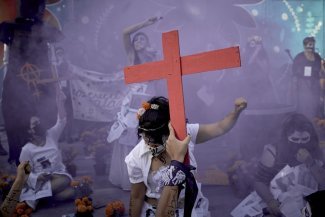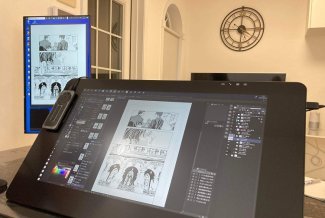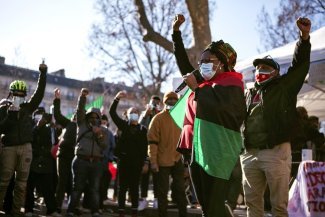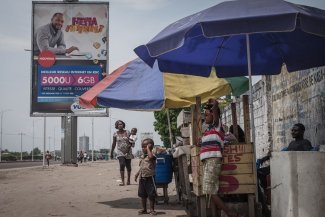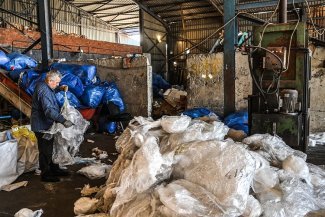How can citizens mobilise and put pressure on climate negotiators without demonstrating? This has been the quandary facing Coalition Climate 21 since 17 November when the ban on the mass marches expected to gather hundreds of thousands of people in Paris on 29 November and 12 December was announced.
The French government imposed the ban during the climate summit following the 13 November attacks in Paris and Saint-Denis, motivated not only by the risk of more terror strikes but also the fear of panic or disorder.
“The government has decided not to authorise the climate marches to be held on the streets,”announced Laurent Fabius, the French foreign minister presiding over COP21.
Coalition Climate 21, bringing together 130 NGOs, trade unions and associations, is still calling for “international mobilisation”, but has had to come up with a plan B.
“We reformulated our planned actions but the police rejected all of our proposals. All actions in open public spaces are banned,” says disappointed Coalition Climate 21 coordinator, Juliette Rousseau.
The coalition has, however, decided to go ahead with the 29 November mobilisation by circumventing the bans: “We are planning a human chain tracing the route the march should have taken,” she tells Equal Times.
It is also calling for “people to gather in other ways: at the terraces of cafes, in bakeries, on street corners, at balconies and windows. A common symbol will also be proposed so that people can express their commitment to the climate on their clothes.”
“We must continue to mobilise because global warming is one of the factors behind the attacks,” says Rousseau. “We know that conflicts like that in Syria are linked to oil and gas. Our climate justice movement is not just trying to defend polar bears, we are also pointing to the fact that as the climate crisis worsens, we will see an intensification of conflict.”
The NGO Avaaz is preparing visual and sound art installations tracing the itinerary of the march to “dress, decorate and occupy the route”.
Avaaz has also come up with an alternative action for the Place de la République in Paris. “We are going to fill the square and the neighbouring street with shoes, to symbolise each one of our steps; thousands and thousands of marching shoes.”
The organisation is calling on everyone to take a pair of shoes, to write their name on them, to decorate them or to put a “message of hope for our future” in them, and to send them to the Avaaz France office in Montreuil.
Largely Internet-based mobilisation
Mobilisation will largely take place via the Internet, with the call for a “virtual march”.
“The march4me website is connecting with people who can march on 29 November and who will represent a French person who cannot,” says Matthieu Orphelin, spokesperson for the Nicolas Hulot Foundation.
The idea? “You put your name and photo on the site and someone in the world will march for you,” he explains. “It is not what we had in mind initially but it is a way of continuing with our actions, because there are going to be 140 heads of state in Paris, it’s the first time they will be meeting since the attacks so they have a duty to come up to scratch and to have an ambitious message.”
Over 50 mass demonstrations have been organised around the world, such as in London, Berlin, Sao Paulo or New Delhi. Even in France, some events are going ahead.
Throughout the duration of the COP21, the Internet will also serve as a channel for signing “Dare”, the call to the heads of state launched in October by Nicolas Hulot on his Foundation’s website, which has already gathered over 625,000 signatures. The petition will then be symbolically handed over to François Hollande.
The scenario for 12 December, the day after the close of the COP21, has also changed.
“We have planned a mass mobilisation divided into small groups that will set off from different parts of Paris,” explains Rousseau.
On the same day, 350.org is calling for “non-violent civil disobedience to show the red lines that have been crossed”, says Eros Sana, a coordinator for this organisation that has also been forced to modify its planned actions.
“Since the attacks, the government has been telling the people of France not to change their way of life, but it will not allow them to express themselves,” Sana tells Equal Times.
“It’s only natural that security measures are taken, but you can’t tell people who want to march that they’re taking a bigger risk than if they go to the Christmas market or to a football match,” he says
There has been no change in other activities. From 26 to 28 November, the Conference of Youth (COY), which should have marked the opening of the various gatherings, should draw some 5,000 people for two days at the Villepinte exhibition park.
On 5 and 6 December, Montreuil should host the Global Village of Alternatives Alternatiba, along with the farmers’ market held by the Amis de la Confédération Paysanne (Friends of the Farm Workers’ Confederation) and the Climate Forum organised by Coalition Climate 21. The Climate Action Zone at the CentQuatre cultural centre, in the 19th district of Paris, will be a daily rendezvous from 7 to 11 December.
Trade unions will also be present in large numbers through the “Trade Union Forum on Climate and Jobs”, during which they will try to make headway with their proposal for a “just transition”.
Not everyone, however, agrees with the high security measures. The civil disobedience group Les Désobéissants has called on citizens to defy the government ban.
“We call on each one of you to come, in a spirit of calm, without hate and without violence, conscious of the unquestionable risks, but present, because the risk of not demonstrating is greater for us,” the group says.
Over 4,500 people have already signed up for the event posted on Facebook.




